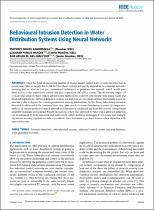 ResearchSpace
ResearchSpace
Behavioural intrusion detection in water distribution> systems using neural networks
JavaScript is disabled for your browser. Some features of this site may not work without it.
- ResearchSpace
- →
- Research Publications/Outputs
- →
- Journal Articles
- →
- View Item
| dc.contributor.author |
Ramotsoela, TD

|
|
| dc.contributor.author |
Hancke, GP

|
|
| dc.contributor.author |
Abu-Mahfouz, Adnan MI

|
|
| dc.date.accessioned | 2021-02-09T13:37:06Z | |
| dc.date.available | 2021-02-09T13:37:06Z | |
| dc.date.issued | 2020-10 | |
| dc.identifier.citation | Ramotsoela, T., Hancke, G. & Abu-Mahfouz, A.M. 2020. Behavioural intrusion detection in water distribution systems using neural networks. IEEE Access, vol. 8: http://hdl.handle.net/10204/11749 | en_ZA |
| dc.identifier.uri | http://hdl.handle.net/10204/11749 | |
| dc.description.abstract | There has been an increasing number of attacks against critical water system infrastructure in recent years. This is largely due to the fact that these systems are heavily dependent on computer networks meaning that an attacker can use conventional techniques to penetrate this network which would give them access to the supervisory control and data acquisition (SCADA) system. The devastating impact of a successful attack in these critical infrastructure applications could be long-lasting with major social and financial implications. Intrusion detection systems are deployed as a secondary defence mechanism in case an attacker is able to bypass the systems preventative security mechanisms. In this thesis, behavioural intrusion detection is addressed in the context of detecting cyber-attacks in water distribution systems. A comparative analysis of various predictive neural network architectures is conducted and from this a novel voting-based ensemble technique is presented. Finally an analysis of how this approach to behavioural intrusion detection can be enhanced by both univariate and multivariate outlier detection techniques It was found that multiple algorithms working together are able to counteract their limitation to produce a more robust algorithm with improved results. | en_US |
| dc.format | Full text | en_US |
| dc.language.iso | en | en_US |
| dc.relation.uri | 2169-3536 | en_US |
| dc.relation.uri | DOI: 10.1109/ACCESS.2020.3032251 | en_US |
| dc.relation.uri | https://ieeexplore.ieee.org/document/9229451 | en_US |
| dc.relation.uri | https://ieeexplore.ieee.org/stamp/stamp.jsp?tp=&arnumber=9229451 | en_US |
| dc.source | IEEE Access, vol. 8 | en_US |
| dc.subject | Anomaly detection | en_US |
| dc.subject | Cyber-physical security | en_US |
| dc.subject | Industrial control systems | en_US |
| dc.subject | Machine learning | en_US |
| dc.subject | Water distribution systems | en_US |
| dc.title | Behavioural intrusion detection in water distribution> systems using neural networks | en_US |
| dc.type | Article | en_US |
| dc.description.pages | 190403 - 190416 | en_US |
| dc.description.note | This work is licensed under a Creative Commons Attribution 4.0 License. | en_US |
| dc.description.cluster | Next Generation Enterprises & Institutions | en_US |
| dc.description.impactarea | EDTRC Management | en_US |
| dc.identifier.apacitation | Ramotsoela, T., Hancke, G., & Abu-Mahfouz, A. M. (2020). Behavioural intrusion detection in water distribution> systems using neural networks. <i>IEEE Access, vol. 8</i>, http://hdl.handle.net/10204/11749 | en_ZA |
| dc.identifier.chicagocitation | Ramotsoela, TD, GP Hancke, and Adnan MI Abu-Mahfouz "Behavioural intrusion detection in water distribution systems using neural networks." <i>IEEE Access, vol. 8</i> (2020) http://hdl.handle.net/10204/11749 | en_ZA |
| dc.identifier.vancouvercitation | Ramotsoela T, Hancke G, Abu-Mahfouz AM. Behavioural intrusion detection in water distribution systems using neural networks. IEEE Access, vol. 8. 2020; http://hdl.handle.net/10204/11749. | en_ZA |
| dc.identifier.ris | TY - Article AU - Ramotsoela, TD AU - Hancke, GP AU - Abu-Mahfouz, Adnan MI AB - There has been an increasing number of attacks against critical water system infrastructure in recent years. This is largely due to the fact that these systems are heavily dependent on computer networks meaning that an attacker can use conventional techniques to penetrate this network which would give them access to the supervisory control and data acquisition (SCADA) system. The devastating impact of a successful attack in these critical infrastructure applications could be long-lasting with major social and financial implications. Intrusion detection systems are deployed as a secondary defence mechanism in case an attacker is able to bypass the systems preventative security mechanisms. In this thesis, behavioural intrusion detection is addressed in the context of detecting cyber-attacks in water distribution systems. A comparative analysis of various predictive neural network architectures is conducted and from this a novel voting-based ensemble technique is presented. Finally an analysis of how this approach to behavioural intrusion detection can be enhanced by both univariate and multivariate outlier detection techniques It was found that multiple algorithms working together are able to counteract their limitation to produce a more robust algorithm with improved results. DA - 2020-10 DB - ResearchSpace DP - CSIR J1 - IEEE Access, vol. 8 KW - Anomaly detection KW - Cyber-physical security KW - Industrial control systems KW - Machine learning KW - Water distribution systems LK - https://researchspace.csir.co.za PY - 2020 T1 - Behavioural intrusion detection in water distribution> systems using neural networks TI - Behavioural intrusion detection in water distribution> systems using neural networks UR - http://hdl.handle.net/10204/11749 ER - | en_ZA |
| dc.identifier.worklist | 23976 |





